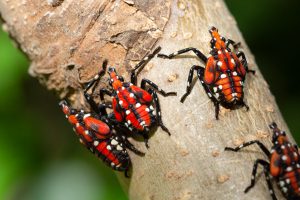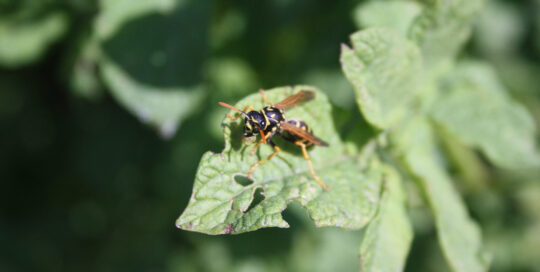Stopping the Spotted Lanternfly to protect our gardens
Views: 2617

It’s the same story. Insects hitch a ride on imported goods, and their population explodes into a severe problem for gardeners and agricultural producers in the new location. In this instance, it involves the spotted lanternfly (Lycorma delicatula) first identified in Pennsylvania in 2014. Quickly spreading to surrounding states there are a number of counties quarantined in Pennsylvania and New Jersey to protect the region.
Spotting a spotted lanternfly
Growing only to about an inch long and 1/2 inch wide, spotted lantern flies an attractive leaf hopper. They sport gray forewings adorned with black spots that create a fine pattern on the ends. And the hind wings have white mid-sections with red patches near the body and black on the ends. The bright yellow on the sides of the abdomen make it look like a glowing lantern.
Why are spotted lanternflies a problem?
As with most non-native insects, the spotted lanternflies do not have natural predators. Even birds won’t eat them since their bright coloration is a natural warning sign. The result is overwhelming numbers that damage plants and cause a mess for homeowners.
The nymphs and adults feed on the plants and trees piercing the plants and sucking out the juices. They have a particular penchant for the non-native tree of heaven, along with grapes, hops, blueberries, fruit trees, and hardwoods. The latter is particularly troubling since Pennsylvania is the top exporter of hardwoods in the country.
Mimosa Trees: A Beautiful, Invasive Species
Not only do these wounds ooze and are susceptible to diseases, the damage reduces the photosynthesizing capability of the individual tree or plant. In large enough numbers, spotted lanternflies can kill the specimen.
Spotted lanternflies also produce a honeydew excretion that encourages black sooty mold, as well as draws in wasps and ants that like it. Plus, it’s just gross. Many times people can’t even set down a glass without finding a lanternfly on it, or in it. And the honeydew gets everywhere.
Proactive steps against the spotted lanternfly
This is the time of the year when the adults lay masses of eggs before the winter, so it’s a good opportunity to be proactive about eliminating them. They don’t fly well, but their eggs end up in the oddest of places.
Egg masses look like blobs of gray, shiny Silly Putty smooshed on the side of a tree, stone, outdoor furniture, or anything with a smooth surface. This is one of the reasons when an area is quarantined, a few surprising items are not permitted are not allowed to move out of the county. Nursery stock makes sense, but because of the nature of the egg masses it also includes firewood, craft pieces using natural materials, outdoor furniture, and even recreational vehicles.
Experts encourage people to kill the insects or the egg masses on sight. By the middle of May, the eggs hatch and the nymphs go through 4 stages before reaching adulthood, ultimately perpetuating the cycle. Squash any adult insects. If there is a large infestation, current recommendations include pesticides with carbaryl, imidacloprid, or dinotefuran. There aren’t any pesticides that kills the eggs so vigilance in the fall is the best line of defense.
Impacts on agriculture
While regions in the East and Mid-Atlantic states are dealing with these intruders, everyone needs to be on the look out for the colorful, but destructive, pests. It’s already been a blow to Pennsylvania jeopardizing $18 billion per year in agricultural. The USDA projects the spotted lanternfly will spread as far as the West Coast if not curtailed.
Although the spotted lanternfly is an overwhelming problem, it’s not a hopeless situation by any stretch. With public awareness and vigilance, they can be contained, if not pushed back. Keep your eyes open for the egg masses in the fall, destroying any you might see. Kill the nymphs and adults as you find them in the spring and summer. If there are any questions or need confirmation, talk to your local county Extension agent. If we stay on top of this, we can stop the lanternfly before it marches west.
Meet Amy Grisak
Amy is a freelance author and photographer in Great Falls, MT who specializes in gardening, foods, and sustainable agriculture. She provides information on every kind…
Amy's Recent Posts

Looking into the Crystal Ball for a Pest Report








